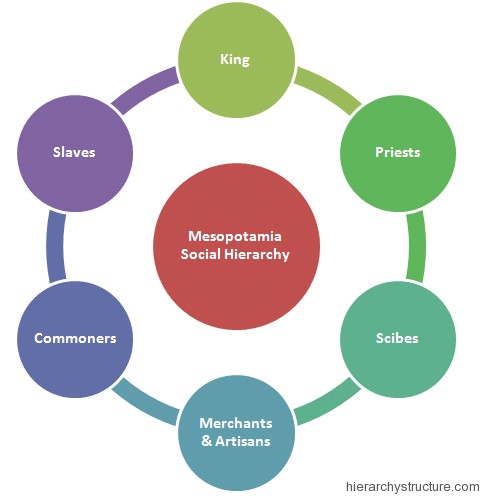The Mesopotamia civilization was situated between the Euphrates and Tigris rivers. Mesopotamia was basically made up of two distinct regions with varied geographies such as Northern Mesopotamia and Southern Mesopotamia. The northern part was made up of hills and plains.
On the other hand, the southern part was composed of flat and barren plains. Due to the unfavorable flood timing, the floodwater used to return to the rivers just before the summer and so the Mesopotamians had to rely on the artificial irrigation systems. The artificial irrigation system led to social stratification and the formation of different communities. The Mesopotamia social hierarchy basically consisted of three classes such as nobility, free citizens and slaves.

The hierarchy of Mesopotamia can be symbolized as a triangle shaped pyramid. If taken in a broader sense, the top of the pyramid consisted of the King and his family, the nobles and their families, the priests and the military leaders. The next level of the pyramid consisted of shop-owners, merchants, farmers, craftspeople, iron workers and fishermen etc. And, the last level was that of the slaves.Below is the detailed structure of the hierarchical structure of the Mesopotamian political society:
- King
- Priests
- Scribes
- Merchants & Artisans
- Commoners
- Slaves
The King:
The King was the top rank holder of the Mesopotamia social hierarchy. The king was responsible for creating the laws. They were believed to as literal gods on earth. They served as the head of the army. They used to wear a lot of jewelry made up of gold and had nice clothing.
Priests:
The priests belonged to the upper class of the society. They were influential because religion was much important at that time and people believed that priests have relationships with the God. They were considered as doctors of the time. In case of any physical illnesses, the people used to request the priests for treatment.
The Scribes:
They also belonged to the upper class and were well educated. They were primarily engaged in various professions such as working in the palace, army, government and merchants etc. Most of them also ran their own businesses as public writers. They had to undergo a specialized training program to be called as a scribe.
Merchants and Artisans:
They also belonged to the upper class. They played the main job role in creating the required wealth for the growth of the civilization. They were known to invent Cuneiform to document the various trade deals. They also invented calenders to keep track of the trades.
The Commoners:
They belonged to the laboring lower class of the Mesopotamia social hierarchy. More than 85 percent of this class was engaged in farming. They were not educated. The other professions of this class included fishing and pottery making etc. They had their own homes. Although their life was not so luxurious as that of the upper class people, they led a comfortable life.
The Slaves:
Slaves were at the bottom of the Mesopotamia social hierarchy. They had no rights and generally worked for the upper class people. The slaves mostly worked in the agricultural fields.
More Resources:
latin america social hierarchy
Ancient greek social hierarchy
Social hierarchy of ancient china
Victorian england social hierarchy
